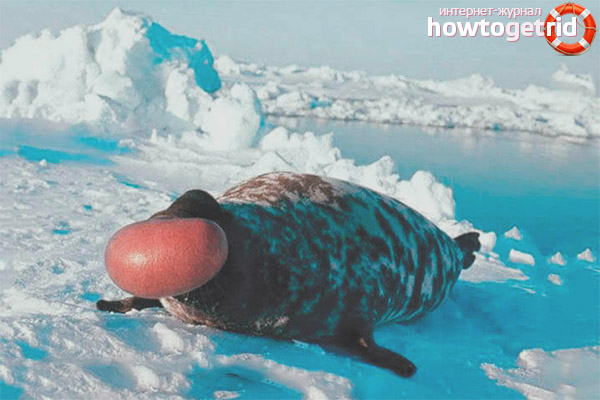The content of the article
Interesting seals live off the coast of Greenland. And they are interesting in that a bubble grows on their forehead and near their nose. True, not always - often animals are seen without him. What are these interesting seals, and why does the bubble appear and disappear, and the animals are called crested seals?
Appearance
Adult males are 2.5-2.7 meters long. Gaining weight 300-320 kilograms. Although there are individuals weighing more - up to 400 kilograms. In females, the sizes are not so large - they are both shorter and lighter. So, the average length of a female seal rarely exceeds two meters and weighs no more than 280 kilograms. The skull in animals is very short, but wide, eyes are large. At the very top of the muzzle is a bubble, in a deflated state similar to a cap. And when the animal is excited, it inflates and becomes wide and long (about 30 centimeters). Thanks to this bubble, the seal got its name.
The skin is painted in light gray tones and strewn with black spots of various shapes, with most of the spots concentrated in the back. On the abdomen there are very few of them, but on the head, which is painted in darker colors than the body, there are almost none.
Habitat
Lifestyle
The crested seal is not very prone to group life, therefore, most of these inhabitants of the northern seas live alone. Together they gather only during the breeding season, and when they molt.
Since Ukrainians are lovers of great depths, you can not meet them near the shore. They are very reluctant to go ashore, spending time, if not in water, then on ice. Seals only climb on them, and when molting occurs. They molt in the first summer months - from June to July. At another time, they swim, looking for prey and feeding fat for the upcoming winter.
Food
Khokhlachi hunt for prey in the depths of the seas, seals dive up to 600 meters and may not appear on the surface for more than half an hour. The record was 55 minutes.
The diet is quite rich in lipids and amino acids, it includes almost all the inhabitants of the northern sea waters from crayfish to capelin. When large prey comes across, well-developed fangs help to keep it.
Seals are adolescents who have just begun to earn their own food, eat amphipods, all kinds of invertebrates, and only then they begin to fish and eat fish.
Breeding

Khokhlaks become sexually mature at the age of three. When a female estrus occurs, the males begin to fight for the female, entering into fights. To frighten the opponent, the male inflates a bubble, and they begin to shake them, while growling loudly. If, after that, it is not clear who dominates, then the males engage in real battle, biting the opponent.
The breeding season begins in March and lasts until the end of April. A pair of seals climb onto the ice floes and mate. Then, all the time, while the pregnancy lasts (and the term is long - 11 months), the couple swims together and catches fish.
Children are born in the month of March - the mother first finds the ice floe and settles it. Childbirth takes a long time, because the baby is born very large: the body length reaches a meter, or even more, and it weighs about 15 kilograms.The body is covered with a short downy cover of blue and gray, for which they were called "blue-backed", and under the skin there is a layer of fat that is absent in other seal children.
Interesting Facts
As already mentioned, the name Khokhlach received for the fleshy outgrowth, located in males on the face, almost on the forehead. He also bears the names of bangs, cap and bag. What is he like? These are ordinary nostrils, only very much overgrown. If the seal is calm, then the bangs in the form of folds hang. If irritated, the holes in the nose close and the bag fills with air produced by the lungs.
The male has another feature - a red bubble is sometimes blown out of the nostril. To inflate it, a seal closes the second nostril and blows into a fold of skin located near the upper jaw. Usually this feature is actively used during mating season to attract attention from females. And in life comes in handy to intimidate opponents. Sometimes and at another time, the crest begins to blow it - so as not to lose the skill ...
Video: crest (Cystophora cristata)










Submit